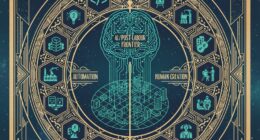Introduction
Artificial intelligence has moved from laboratories into our homes, offices and public debates. One of the more unusual voices in this landscape is Thorsten Meyer, a Munich‑based futurist, author and self‑described post‑labor economist. Meyer is not a university academic but an entrepreneur who uses large language models (LLMs) to operate a vast network of niche publications and to explore social questions about work and value. His projects range from StrongMocha, a multi‑platform media network that uses AI for editorial workflows, to public discussions on universal basic income (UBI) and the ethics of automation. This essay contextualises Meyer’s career, his AI‑driven publishing empire, his concept of post‑labor economics and the debates surrounding his work.
Professional background
Thorsten Meyer’s professional career predates his public role as an AI commentator. On his personal site he explains that he spent over two decades in the information and communication technology sector leading global product strategy, steering acquisitions and managing portfolios exceeding €100 millionthorstenmeyerai.com. He began integrating AI and machine‑learning systems into enterprise products as early as 2017, well before the rise of generative‑AI chatbotsthorstenmeyerai.com. This technology‑industry background underpins his later emphasis on pragmatic, applied AI rather than purely theoretical models.
Founder of StrongMocha News Group
In 2007 Meyer founded StrongMocha News Group near Munich. He describes its original purpose as empowering niche communities with “smart, useful and deeply relevant” contentthorstenmeyerai.com. The company has evolved into a network of over 250 (by some reports over 300) digital magazines and brands. It spans topics from technology and creativity to lifestyle and industrythorstenmeyerai.comdeepintellica.com. Unlike conventional media houses, StrongMocha relies heavily on LLMs and automation for content generation, planning and search‑engine optimisation. Each site functions as a testbed for scaling “intelligent workflows, SEO automation, affiliate monetisation and contextual editorial intelligence”deepintellica.com. StrongMocha’s architecture demonstrates Meyer’s argument that AI can industrialise publishing by replacing manual processes with agent‑driven workflowsdeepintellica.com.
Recognition from OpenAI
Meyer’s team claims that their AI systems have processed more than 10 billion tokens through OpenAI’s API. In October 2025 StrongMocha announced that OpenAI had presented Meyer with a “10 Billion Token Award”, a custom anodised aluminium token acknowledging his network’s large‑scale API usagethorstenmeyerai.com. StrongMocha described this milestone as “one of the largest verified AI‑powered workloads globally by an independent creator and media network”strongmocha.com. OpenAI’s note accompanying the award emphasised that the recognition was intended to celebrate real‑world change achieved through large‑scale API usestrongmocha.com. This award is not widely publicised outside of Meyer’s own media ecosystem, but it underscores the scale of his AI‑driven operations.
Post‑labor economics and thought leadership
Central to Meyer’s writing is the idea of post‑labor economics. He argues that artificial intelligence is not just a productivity tool but a societal restructuring mechanismdeepintellica.com. On his website he explores how automation, UBI and “intelligent agents” could dissolve traditional employment models, pushing humans toward creative and strategic pursuitsdeepintellica.com. His articles urge policymakers and executives to recognise that automation is not a future threat but a present reality that demands new economic and social frameworksdeepintellica.com.
Agentic commerce and “vibe coding”
Within the post‑labor framework Meyer proposes concepts such as Agentic Commerce and Vibe Coding. Agentic Commerce envisions businesses built around self‑coordinating AI agents, replacing teams of employees with autonomous agents that negotiate, execute and optimise tasksdeepintellica.com. Vibe Coding refers to the emergent language and culture that arises when humans collaborate with generative AI tools; it involves designing prompts and workflows that produce outcomes aligned with human intent rather than deterministic code. These ideas stress adaptation to a future where software agents interact like economic actors.
Advocate for private and sovereign AI
While he embraces large language models, Meyer warns against over‑reliance on hyperscale cloud providers. He advocates for private, locally controlled AI infrastructure and emphasises “trust, sovereignty and privacy”deepintellica.com. His white papers on “Private GenAI for Enterprises” and “AI Ops & Observability” (referenced in his articles) propose architectures where organisations deploy secure LLMs on‑premises or within regulated cloudsdeepintellica.com. This position aligns with European debates on sovereign AI infrastructure and resonates with enterprises concerned about data exposure and regulatory compliance.
Merging technology, business and culture
Meyer strives to bridge technical discourse with cultural and human dimensions. He notes that his essays and videos examine how exponential technologies reshape work, wealth and the “human experience”thorstenmeyerai.com. On Deep Intellica he is praised for blending technical precision with cultural literacy, linking AI developments to shifts in creativity, identity and purposedeepintellica.com. Projects like AI Daily Brief and a free self‑directed course on agentic AI and vibe coding aim to democratise advanced AI literacydeepintellica.com. In his own words, his mission is to “translate complex, tech‑driven change into insight you can act on”thorstenmeyerai.com.
Publications: the Global Mindset Series and beyond
Meyer has authored several books, collectively marketed as The Global Mindset Series. According to his website and publisher descriptions, the series includes:
| Title | Key themes | Source |
|---|---|---|
| Navigating the AI Revolution (2024) | Explores human adaptability, ethics of AI, human–AI collaboration, workforce impact, transformations in healthcare and education, and frameworks for ethical AI governancebooks.apple.com. Drawing on over 30 years of corporate experience, the book seeks to bridge cutting‑edge AI technology with practical applicationsbooks.apple.com. | Apple Books previewbooks.apple.com |
| Cultural Intelligence | Addresses cross‑cultural leadership in a globalised, AI‑mediated world. While detailed contents are not available on public sites, the title suggests combining socio‑cultural awareness with technological literacy. | Listed in Meyer’s biographythorstenmeyerai.com |
| The AI Bifurcation (co‑authored with Aiko Tanaka) | Introduces the notion of a growing divergence between human and artificial intelligence, examining how machine capabilities may surpass human abilities in specific domains while humans retain advantages in creativity and complex decision‑makingthorstenmeyer.com. | Book overviewthorstenmeyer.com |
He also writes stand‑alone works — The Creative Spark, Positive Thinking Day and Harmonies and Horizonsthorstenmeyerai.com — and publishes communication and parenting guides under the pseudonym Claude Bensonthorstenmeyerai.com. These guides (e.g., How to Talk So Your Teenager Will Listen, Byte‑Sized Parenting and Survival Guide for New Dads) show his interest in human relationships and digital‑age communicationthorstenmeyerai.com.
Metrics: scale of Meyer’s AI ecosystem
To appreciate Meyer’s influence it helps to summarise the scale of his operations:
| Metric | Figure | Context & source |
|---|---|---|
| Years in ICT before focusing on writing | >20 years | He led global product strategy, acquisitions and portfolios >€100 millionthorstenmeyerai.com. |
| Number of brands/platforms in StrongMocha | >250 (sometimes cited as >300) | StrongMocha publishes across technology, lifestyle and industry nichesthorstenmeyerai.com; Deep Intellica describes “over 300 active media brands”deepintellica.com. |
| Tokens processed via OpenAI API | >10 billion | StrongMocha announced that OpenAI recognised Meyer with a 10 billion‑token awardthorstenmeyerai.comstrongmocha.com. |
| Books authored | >10 | Three‑book Global Mindset Series plus multiple stand‑alone works and parenting/communication guidesthorstenmeyerai.com. |
Influence, reception and debates
Meyer’s voice resonates with certain technology and business audiences, particularly those curious about AI’s long‑term socioeconomic effects. His AI Unfiltered YouTube series, weekly essays and newsletters attempt to make complex ideas accessible. The Deep Intellica profile portrays him as a “futurist of function” who builds systems rather than merely prognosticatesdeepintellica.com, and emphasises his message that the future should be “about designing intelligent systems that reflect human values”deepintellica.com.
However, critical evaluation is necessary. Much of the available information about Thorsten Meyer comes from his own websites (ThorstenMeyerAI.com, StrongMocha.com, Deep Intellica) or affiliated platforms. There is scant independent reporting on his achievements, and awards such as OpenAI’s “10 Billion Token Award” appear to be unique recognition programmes rather than widely recognised industry benchmarks. His frameworks like Agentic Commerce and Vibe Coding are speculative and may not yet be supported by peer‑reviewed research. Scholars of labour economics debate whether automation will create or destroy jobs; Meyer’s post‑labor vision takes the pessimistic view that many traditional jobs will disappear, whereas other economists argue that AI may complement human labour or generate new forms of work. Likewise, universal basic income remains a contested policy, with trials (e.g., Finland’s UBI experiment) showing mixed results on well‑being and employment.
Another critique concerns scale and sustainability. Operating hundreds of AI‑driven sites raises questions about quality control, misinformation and the ethical deployment of generative text. StrongMocha emphasises editorial integritydeepintellica.com, but independent assessments are lacking. As AI‑generated content proliferates, transparency about authorship and accuracy becomes increasingly important.
Conclusion
Thorsten Meyer occupies an intriguing niche in the AI landscape: a builder who uses large language models to demonstrate what a post‑labor media infrastructure might look like. His career spans corporate technology leadership, entrepreneurship and futurist writing. Through StrongMocha he has operationalised AI at scale, reportedly processing billions of tokens and managing hundreds of specialised publicationsdeepintellica.comstrongmocha.com. His concept of post‑labor economics challenges readers to imagine a society where machines perform most routine work, prompting debates about UBI, human creativity and the design of agentic systemsdeepintellica.com.
Meyer’s work is not without controversy; much of the evidence comes from his own network, and his speculative frameworks lack rigorous empirical validation. Nevertheless, his emphasis on privacy, sovereignty and ethical AIdeepintellica.com, coupled with his call to design technology around human valuesdeepintellica.com, offers a valuable counterpoint to purely techno‑optimistic narratives. Whether or not one accepts his post‑labor thesis, engaging with Thorsten Meyer’s ideas encourages a broader conversation about how AI should reshape work, wealth and culture.







